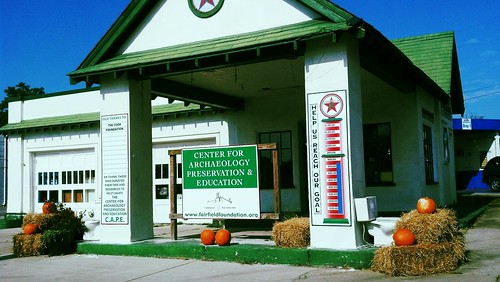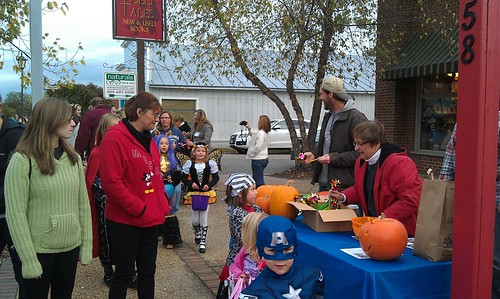The following is the third installment in a series of blog posts focused on the oral history project directed by University of Florida graduate student Jessica Taylor, aimed at recording oral histories about the Edge Hill Service Station and Gloucester’s Main Street community. Prior to conducting the interviews, Jessica outlined for us the importance of oral history. After transcribing many hours of personal interviews, she wrote a second blog post sharing some heart-warming stories and memories of good times in Gloucester and Mathews. Read on to learn about the kinds of Halloween mischief engaged in by Gloucester natives in years past!
For well-known Gloucester resident Harvey Morgan, Halloween excitement began in August, and no one was more excited than Harvey.
HM: One August I decided I had an idea for Halloween. So, I began saving a few eggs and I put them aside and I saved, I don’t know, a dozen of them or more. By Halloween, they were pretty rotten.
Harvey waited patiently through two months of silent anticipation to put his plan into action. Like other young men in Gloucester, he began planning lightning strikes and choosing targets months in advance.
When County Clerk B.B. Roane discovered his front gate hanging off of the Courthouse flagpole on the morning of November 1st, he might have asked himself why. The answer lies partially in the American expression of the Halloween tradition: the night was, for children and the poor, a “ritual of inversion,” during which it was acceptable to demand things from and act arbitrarily toward the people that normally did the demanding. The deal was, of course, that the nonsense ended on November 1st. A single, designated night of mischief gave adolescents a time and place to blow off steam without threatening established hierarchies. In Morgan’s words, “We never really did anything bad, but we were very mischievous.”
Reading through the oral history transcriptions for mentions of Halloween, I was surprised to find that only young men terrorized Gloucester. In fact, women who were the adolescents of the forties and fifties had little to say about it at all, except dismissively. Joyce Williams said, “I don’t think my parents would let me go out,” and Betty White slyly pointed to the boys’ triviality:
JT: Well, tell me about that. What’d they dress up like, who’d they go see?
BW: Well, I don’t remember what they dressed up like.
BW: Clowns, probably.
It may be that women are less likely to brag about mischief. Or, maybe there’s a statement to be made about the role of women in the 1940s and 1950s: often subject to more parental supervision, young women were less likely to go out late on Halloween night. But even if they did go out, what role should they play in a ritual of inversion played out between men and young men? Instead, they just had a different Halloween experience altogether. Consistently, women’s memories of Halloween night center on the family-oriented early evening, when younger children go trick-or-treating while parents socialize. Betty White remembers the Halloween Parade on Main Street, “being at a restaurant, watching all the youngsters and the adults parade up and down and everyone is so cheerful about it. It’s a neat custom I think.”
 The CAPE is ready for Halloween on Main Street!
The CAPE is ready for Halloween on Main Street!
Then the sun went down and Harvey Morgan came out. Although some teenage boys like Hayes Williams snuck through front yards to “scratch on people’s window screens and run,” adolescents like Harvey Morgan frequented the same places where they had just a few years earlier gone trick-or-treating: Main Street and the court circle. The court green itself was strewn with toilet paper on Halloween night, and B.B. Roane’s gate was one of a few things in the court circle not adequately secured to the ground. The rest of Harvey’s egg scheme demonstrates that these public spaces became post-apocalyptic battlegrounds on October 31:
HM: Then I took these little paper bags and put flour in them, and then put one egg in the shell very carefully in and rolled it up. There was a flour bomb with rotten eggs. So, I would climb up on top of the old drugstore, which is as I said the antique store now. I would shimmy up the downspout and walk up to the front of the store, and as the militia would walk along, I would drop them. I didn’t actually hit anybody, but I think I hit one on the toe one time. But as soon as it did, I would run to the back and climb down and then run down the street. This one night, one particular time, I was being chased and I ran as hard as I could. I came to a hedge and I jumped over the hedge and just lay down and gasped. My heart was racing, and I knew that they could hear me but they went on by. They never found me.
The militia, sent to keep order on Halloween night, became the targets of flour-bomb strikes exactly because they were sent to keep order. Like the clerk’s office and the court green, the businesses on Main Street represented authoritative and adult spaces that adolescents knew well but claimed no ownership of—even Harvey’s father’s drugstore. In Harvey’s case, subverting authority involved using these spaces in creative ways—navigating through downspouts, roofs, and hedges—to remain anonymous. Getting caught and punished, after all, would defeat the purpose of flouting authority.
Whichever version describes your childhood, Gloucester’s Main Street is the setting for the perfect Halloween. George Rhodes reminds us that without the centrality of Main Street to business and population distribution, there wouldn’t be trick-or-treating in the Courthouse at all.
GR: Gloucester hadn’t had its growth spurt start so there weren’t any real subdivisions. People just lived down the road somewhere. [Laughter] Gee…but at that time, people would come from their homes into town to trick-or-treat, because you’ve got house next to house next to house up and down two or three of the main streets.
 The Fairfield Foundation was one of many local businesses and organizations handing out candy to trick-or-treaters on Main Street in 2012, as part of a traditional Halloween event in Gloucester.
The Fairfield Foundation was one of many local businesses and organizations handing out candy to trick-or-treaters on Main Street in 2012, as part of a traditional Halloween event in Gloucester.
Carol Steele, head of Parks, Rec, and Tourism, recognizes the family approach to Halloween as the root for Gloucester’s modern traditions:
CS: And then I think that the small town kind of thing that you want to feel, that Norman Rockwell, and our main street is this eclectic, architectural, fun street that’s got all kinds of generational things going on. So when you have our Main Street Association sponsor the Halloween event, and they’re closing the road down and they’re letting all these kids come out, and they’re going store to store and stuff- they’re gonna remember that all their lives. And they’re gonna want their kids to have those same experiences.
When the sun goes down this Thursday, check the rooftops before you walk down Main Street. Harvey Morgan’s waiting.
We want to thank again all the folks that sat down with Jessica for interviews about their memories of Main Street. Your stories are part of our history. If you have more stories to tell, or know friends who keep reminiscing about the past, share them with us here, or get in touch with us. We’d would be happy to sit down with you and talk about the good ole days.


Neat stories. You’re doing a great job of preserving special Gloucester history!